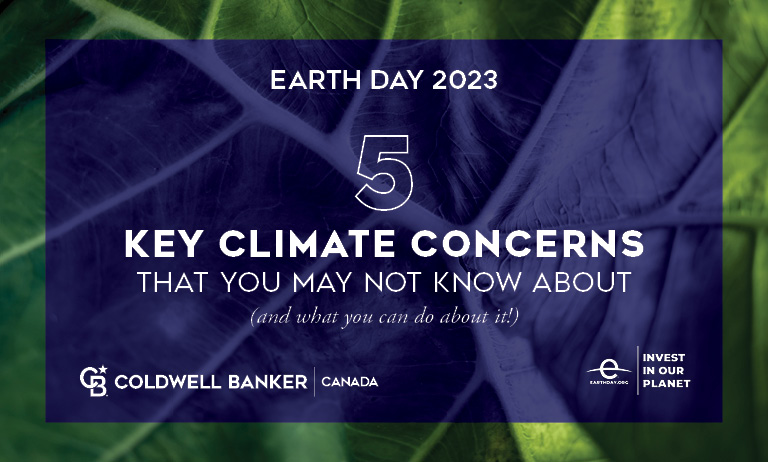5 Key Climate Concerns That You May Not Know About

Earth Day is the annual global event happening this Saturday, April 22, 2023. The theme for this year is “Invest In Our Planet”, in hopes to brings attention to the importance of dedicating time, energy, and resources to proactively help solve climate change and other environmental issues.
We talk a lot about our homes, whether we’re buying, selling, renovating, or just living in, and Home is the heart of our core values and our lives. For Earth Day this year, it’s time to talk about everyone’s home: Earth.
Here’s a list of 5 key climate concerns that impact us all, and a few things you can do about it!
1. Thawing Permafrost
- What it is: Covering 24% of the surface of the land mass in the northern hemisphere, the 9 million square miles of permafrost (thick subsurface soil layer frozen year-round) holds up to 1,600 gigatons of carbon, nearly double what exists in the atmosphere.
In a nutshell, the permafrost is heating up faster than expected, causing a significantly higher amount of greenhouse gases to be released which speeds up global warming, thus further feeding into the accelerated cycle to thaw/release. As the ground thaws, ice melts and alters the landscape creating pockets where water sits. That water speeds up thawing further, causing the land to shift which then releases the long-stored pockets of carbon. The carbon gets released as carbon dioxide and methane, which is 25 times more potent than CO2. Methane is responsible for around 30% of the rise in temperature and contributes to the spread of Arctic wildfires with devastating effects, adding to the positive feedback loop. The Arctic is warming up annually at more than twice the rate of the rest of the planet, allowing this release of gases to happen year-round as opposed to in the few summer months of previous years. Warmer temperatures also lead to less snow over winters, creating a darker landscape that absorbs rather than reflects the sun’s rays, resulting in further heating of the land.
Greenhouse gases absorb and retain solar energy in our atmosphere, causing the “greenhouse effect” or the heating of our planet. According to National Geographic, “From the unexpected speed of Arctic warming and the troubling ways that meltwater moves through polar landscapes, researchers now suspect that for every one degree Celsius rise in Earth’s average temperature, permafrost may release the equivalent of four to six years’ worth of coal, oil, and natural gas emissions—double to triple what scientists thought a few years ago.”
- Why it matters: The thawing of permafrost was not taken into account in previous climate models, meaning that climate change is happening faster than expected and that current plans to curb emissions are not sufficient as once thought. The more carbon that’s released into the atmosphere, the faster the effects accelerate. The results effect all of us, from warming temperatures, unpredictable and devastating weather events, to rising sea levels, habitat and food source loss for animals, among a multitude of other things.
- What you can do: This is challenging to solve as scientists are unsure how to tackle this issue at the scale and rate that is required but there are still ways you can make a change. You can lobby for policy change to cut emissions at a more efficient rate. Consider your reliance on fossil fuels not only by driving less, but also it’s use in powering electricity, and think about our desire and demand for products, much of which is manufactured with the use of fossil fuels (not to mention less pollution or the energy and resources used in shipping). Explore switching to alternative energy sources, and give thought to purchasing less.
2. Monoculture Lawns & Landscaping
- What it is: Monoculture lawns or landscapes are areas that have been developed to contain only one or a few types of species. While relatively new, it’s now hard to imagine our homes and cities without them. Modern lawns as we know them were developed in the 1860’s and have only been common-place since the 1950’s.
- Why it matters: When there’s a lack of diversity in an ecosystem, it is left vulnerable to disease and invasive species, while providing very little nutrition or shelter for pollinators, insects, or birds. Maintenance requires hundreds of litres of water, and use of chemical pollutants and gasoline. Gas powered mowers emit 11 times more air pollution than a new car for every hour of operation and two-stroke engines such as those used in hedge trimmers are notoriously inefficient.
- What you can do: Leave clippings on your lawn and mow as little as possible, an ideal amount being once every two – three weeks. Consider replacing your lawn with a permaculture of a variety of native plants including flowers and different grasses. This helps to create more nitrogen-rich soil and allows the plants to grow together naturally, requiring less maintenance.
3. Drying Wetlands and Peatlands
- What it is: Making up 6% of the world’s surface, wetlands and peatlands play extremely important roles for our planet and store approximately a third of the worlds carbon. Inland wetlands are swamps, bogs, and waterlogged areas which can be both salt and freshwater, and coastal wetlands contain brackish water (a mix of salt and fresh) and are mangrove forests and marshes. Peatlands make up half of the worlds wetlands and are defined as a wetland with thick water-logged soil layer made up of dead and decaying plant material. All of these wetland types are diverse and productive ecosystems and are home to a number of species, some of which are endangered, and as they exist in multiple regions around the world, are also part of migration corridors for birds and other migratory animals. Humans also rely on them as sources of food and rice farming and play a large role in the global fish consumption, affecting two-thirds of the fish we eat.
They are also considered carbon sinks – areas that absorb more carbon than they produce – and destroying these areas will release this into the atmosphere. Humans are destroying these areas by draining them for crops, land developments, and by stealing the water supply for our own irrigation purposes. In certain areas, peat is removed and burned for energy. Canada is home to one-third of the worlds peatlands but in settled areas, we’ve destroyed almost 70% of it as a result of our farming and development practices.
- Why it matters: Due to the large carbon stores, the results of these areas drying up could allow for 860 million tonnes of carbon dioxide to be released every year by 2100. Additionally, loss of these ecosystems also means the loss of life for inhabitants. These areas also buffer storms, absorb excess nutrients and rainwater preventing flooding and damage, and slow erosion.
- What you can do: Only one-eighth of Canada’s peatland is protected, so it’s important to take part in or start up a peatland restoration project and help protect these areas. Build up and down instead of expanding into areas that don’t naturally sustain development.
4. Unnecessary Home Renovations
- What it is: Not referring to serious issues such as electrical, asbestos removal, or improving insulation, this is about keeping up with the Jones’s, following design trends, or remodeling based on simply ‘desiring’ a new look.
- Why it matters: The act of replacing requires waste in terms of materials discarded, the energy used, and in demand and production of new materials. Building materials and major appliances are among the major sources of pollution in Canada, making up part of the 36% of non-degradable waste that ends up in landfills yearly. According to Visual Capitalist, “renovations can generate approximately 60 pounds of waste per square foot on average.”
- What you can do: Consider refacing, painting, or repurposing existing furniture or items. If you must renovate, source reclaimed or sustainable materials that will reduce future waste, and recycle or donate old materials. Focus on energy-efficiency and introduce high quality insulation. Try to source skilled contractors who should ensure less issues during renovation saving both time and money. If feasible, repair instead of replacing appliances. You can also learn to love and embrace your home as it is, maybe there is nothing wrong with it. We easily get caught up with the Instagram-worthy ideals and it can make our own lives appear tired or dull and it’s worth stepping back to consider our homes and lives objectively.
5. Disinformation
- What it is: Disinformation is the act of intentionally providing false information with the intent to mislead. It should not be confused with misinformation which involves false information that is not necessarily intentional, however these two terms are often connected. Disinformation about climate change will likely tell you things such as “Climate change isn’t real”, “renewable energy is bad”, or will refer to environmental disasters as “scams” and the like.
- Why it matters: Disinformation is usually spread throughout the internet and detracts from true facts and information which takes emphasis away from the very serious environmental issues and delays action. Whether or not someone falls for the disinformation, it creates confusion, a lack of urgency, and even a distrust of science.
- What you can do: Make sure your information comes from a reputable source. It’s easy to be swayed by an image with a statement that we see on the internet when it agrees with our biases but it’s important to remember that everything can easily be altered to fit a viewpoint or taken out of context. Have an objective mindset and do your own research outside of social media and video channels. Ask yourself if the data has sources and studies behind it, and read the studies too if available – results can be misrepresented to adhere to a viewpoint so it’s important to get as much of your own information as possible. When you see blatant disinformation, don’t let it slide by and encourage sharing of factual information.
Other ways to take part:
- Get involved! Find an event in your area to take part in, from community clean ups to tree planting. Here’s a link to find events in your area!
- Learn about it – education is power, here are some tools to help support climate literacy.
- Plant and conserve trees – they provide shade helping to cool the earth, reduce carbon emissions, help prevent wind erosion to name just a few things. Treed neighbourhoods are also cooler, leading to lower energy bills in the summer. If you think back to your high school chemistry, you might remember that carbon dioxide is 2 oxygen atoms and 1 carbon atom, and trees help by absorbing CO2, storing the carbon and releasing the oxygen allowing us all to breathe.
- Speak up for change! Collectively we are all capable in fixing the planet.
- From Earthday.org, here are 52 Ways to Invest in Our Planet.
- Purchase less. Our culture of overconsumption and waste is a driving force behind many of the world’s issues, and the demand to immediately and constantly have new products and services is an anomaly in human history and is not sustainable. This affects not only the environment, but also our mental health, levels of happiness and satisfaction, and likely has unforeseen impacts on future generations.
There are so many ways to take part, whether it’s with a conscious and quiet personal choice to consume less, a family decision to explore alternative energy for the home, less driving with remote work in organizations, or taking part in large-scale efforts of preservation, the investment we make today will mean a world of difference for the future.
Earth Day is an annual event every April 22, starting in 1970. See how it all came about here.
Information referenced from:
https://www.iea.org/reports/global-methane-tracker-2022/methane-and-climate-change
https://blogs.scientificamerican.com/brainwaves/outgrowing-the-traditional-grass-lawn/
https://www.cbc.ca/news/science/what-on-earth-newsletter-garden-lawn-1.5200383
https://www.nationalgeographic.com/environment/article/what-are-wetland-ecosystems?loggedin=true&rnd=1682000890342
https://archive.curbed.com/2018/3/7/17087588/home-renovation-unnecessary-mcmansion-hell-wagner
https://www.apartmenttherapy.com/home-remodeling-negative-effects-260749
https://blueandgreentomorrow.com/environment/horrific-environmental-costs-of-wasting-appliances/
https://publications.gc.ca/collections/collection_2020/eccc/en14/En14-405-2020-eng.pdf
https://www.apa.org/topics/journalism-facts/misinformation-disinformation
Trends for Commercial Real Estate in 2023

The real estate market and interest rates have been very hot topics over the last year. We have seen house prices rise and fall and inflation is the highest it has been since the 1980’s. While interest rates are still high, we have now witnessed the Bank of Canada hold the overnight rate for two consecutive announcements, but there are still many hurdles in the real estate world. Curious what will be trending in Commercial real estate in 2023? Let’s take a look!
The 3 areas that will have the biggest focus for 2023 are:
- Sustainability and focus on Environmental, Social and Governance (ESG)
- Supply issues and inflation
- Housing affordability crisis
Focus on Sustainability and Environmental, Social and Governance (ESG) Concerns
Focus on climate change and sustainable development has been trending for a while now as companies hope to achieve net-zero emissions in the coming years. It is imperative that companies and developers have an ESG plan as achieving net-zero emissions is the new standard. Having an ESG strategy will not only help companies to assure investors and employees that they are forward-looking and see the value in sustainability. It is common now for investors to demand to see a net-zero strategy before moving forward, as expectations toward ESG best practices are emerging. With higher interest rates, it’s not as easy for companies to gain capital as it was in previous years, which is why having a strong ESG strategy will be beneficial. Companies need investors in order to further development projects and having a focus on climate change and sustainability will give some companies an edge against their competitors.
Supply Issues and Inflation
In a time of uncertainty and rising costs, it is difficult to know when to take risks and when to play it safe. With interest rates still high and potentially climbing, along with the rising cost of building supplies, commercial real estate is being impacted. With building and material costs being on the rise, labour costs have also been making development projects much more expensive than they were in the past. Not only do developers need to take price increases into account, but they will also need to consider climate change and sustainability when choosing building materials. In fact, according to Statistics Canada, in the first quarter of 2022, construction costs were 12.8% higher than they were in the first quarter of 2021. As a result, some investors and developers are choosing to take a pause to allow inflation and the supply chain to readjust.
Housing Affordability
Higher interest rates and lack of supply have created a housing affordability crisis in Canada, which has caused Canadians to look at renting rather than buying homes. Higher rates and inflation have made it more difficult for Canadians to buy property and increased the costs associated with new construction. Across Canada, the average minimum income required to purchase a home now requires an additional $5,000 to $21,000, the amount varying by city.
As a result, we are seeing buyers continue to wait on the sidelines, causing the rental market and prices to inflate.
An opportunity that has been discussed is office building conversions. With the shift to working from home, there are plenty of office buildings that are either empty or at very low capacity, making these buildings great candidates for rental conversions.
What’s Next?
Government involvement and assistance along with developers creating strong ESG strategies will offer some relief in the short term. As the real estate market resets and recovers, we are going to need to see government solutions to help with the affordability crisis in Canada and lack of housing supply and if developers want to see money from investors, they are going to need to have net-zero strategies in mind.
Information referenced from:
https://www.loopnet.com/learn/what-to-expect-in-canadian-commercial-real-estate-in-2023/1725921854/
https://www.pwc.com/ca/en/industries/real-estate/emerging-trends-in-real-estate.html
https://dailyhive.com/canada/home-prices-in-canada-income-march-2023
What It Takes to Be a Successful Realtor

What skills do successful Realtor’s have?
- Communication skills
- Understanding of real estate
- Knowledge of your local market
- Time management skills
- Negotiation skills
- Marketing skills
Communication
Being able to communicate with your clients is the #1 key to being a successful Realtor. Whether it be a verbal conversation, a written document, or simply being able to actively listen to their requests or concerns, communication is extremely important.
Communcation skills can be broken down into 4 categories:
- Verbal Communcation: How you speak to your clients and the terminology you use will impact your level of verbal communication. Speak with confidence and avoid using technical or overly complicated language.
- Nonverbal Communication: Body language and eye contact are very effective forms of communication. It is key to ensure that your clients feel important and that you care.
- Active Listening: Listen to your clients will ensure that you understand your clients. Listen, ask questions, and repeat their answers so your clients feel that you understand.
- Written Communication: Being professional in all written communication is necessary in real estate.
Understanding of Real Estate
Similar to most other industries, keeping up with the latest trends and continuing to educate yourself will make you more confident and comfortable in your career. Utilize local or national news sources to keep up with the latest market updates.
Knowledge of Local Market
Local knowledge of the market makes all the difference in real estate. Your clients want to know the neighbourhood information including schools, taxes, public transportation, and more.
Time Management
A career in real estate offers plenty of flexibility but being able to manage your time effectively is imperative given the lack of structure. Scheduling showings, meeting with clients and any other day-to-day activities can be very sporadic and can often involve working on weekends or outside normal working hours.
Marketing
Being tech and social media savvy acts as an advantage in today’s real estate market. Using social media, personal websites and other digital assets are great ways to market your listings and you! Having a digital presence will help you get found and will show your clients that you truly are an expert in your field. Social media has been a huge advantage for individuals in not only real estate, but business in general. It has allowed people to build a business and generate income from the comfort of their home.
Do you have what it takes to be a successful Realtor?
Information referenced from:
https://www.theceshop.com/agent-essentials/real-estate-agent-encyclopedia/real-estate-skills
Things to do in Vancouver While You’re Here for Gen Blue Canada!

This spring, Coldwell Banker Canada will be bringing our blue pride to the beautiful city of Vancouver. Blessed with majestic mountains, the sparkling ocean, lush rainforests, and an array of notable attractions, Vancouver is one of Canada’s most desirable places to visit.
We have guests from across Canada flying in for this special event, and we want to make sure everyone makes the most of their visit! Whether this is your first time travelling to Vancouver or you’re a local looking for new adventures, we’ve curated a list of the best things to do in this bustling city.
Explore Stanley Park
Stanley Park is Vancouver’s largest and most adored park! This green oasis is located right along the Seawall and offers 400 hectares of luscious rainforest, kilometers of trails, stunning beaches, wildlife, delicious food, cultural landmarks, and unlimited scenic views of Vancouver’s beautiful landscape. Stanley Park offers something unique for everyone!
Visit the Richmond Night Market
The Richmond Night Market is the largest in North America and is the perfect spot to eat, play, and shop! With 70 food vendors and 100 retail stalls, you can fully indulge in this epic tradition. Feast on some of the most delicious Asian food while shopping for handmade, local merchandise.
Take an Aquabus to Granville Island
It comes as no surprise that Granville Island is a favorite spot for many visitors and locals alike! The Granville Island Public Market is a bustling hub of activity AND an important cultural district. The area is home to an endless number of restaurants and food stands, two breweries, a spirits distillery, and many theatres, workshops, and craft studios.
Cycle or Walk the Vancouver Seawall
The Seawall in Vancouver extends from the Vancouver convention Centre to the Spanish Banks Park, but the most popular section is the 10-km loop around Stanley Park. The Seawall caters to both walkers and cyclists so you can choose how would like to experience the lush greenery, the ocean views, and the freshest air around.
Tour Gastown
Gastown is located along the north of the downtown Vancouver peninsula and is the city’s oldest neighborhood. You’re going to want to explore this neighborhood by foot to admire the Victorian architecture, adorable boutiques, and unique galleries while enjoying some of the best food in the city!
Visit the Vancouver Aquarium
The Vancouver Aquarium is Canada’s very first public aquarium and contains the country’s only dedicated marine mammal facility. It is home to thousands of incredible ocean species and aquatic life and provides an educational, awe-inspiring experience for guests of all ages.
Take a Foodie Tour
Vancouver’s culinary scene is one of the most vibrant in Canada, offering a huge variety of quality cuisine. You can expect to find some of the finest restaurants in the world, superb street food, and everything in between. If you consider yourself a foodie, you should consider taking a Foodie Tour for a guided experience where you’ll get to try incredible food from multiple vendors!
Enjoy Live Music at The Commodore Ballroom
The Commodore Ballroom is an award-winning venue that has hosted some of the most legendary talent for the past 90 years, including KISS, David Bowie, the Tragically Hip, Lady Gaga, and so much more. Named one of the Top 10 Most Influential Clubs in North America and Vancouver’s favorite live venue, it’s definitely worth the visit!
Admire the Van Dusen Botanical Garden
If you consider yourself a nature lover, you’re going to want to check out the Van Dusen Botanical Garden, a 55-acre oasis in the heart of Vancouver. There are over 7,500 plant species and varieties from around the world to admire, and you’ll likely encounter some local wildlife as well. The garden features an Elizabethan hedge maze, a delicious care and restaurant, and a lovely garden themed gift shop!
Catch the Sunset at Kitsilano Beach
Vancouver’s mountain landscape make for some incredible sunsets. If you don’t believe me, then you should head over to Kitsilano Beach to see for yourself! Kitsilano Beach is one of the most popular beaches in Vancouver, offering panoramic views of downtown, Burrard Inlet, and the North Shore Mountains, making this the ideal spot to wind-down and enjoy a sunset.
Walk Across the Capilano Suspension Bridge
The 450-foot Capilano Suspension Bridge is a sight to see, surrounded by the rich rainforest, rushing river, and incredible views from every angle. The park also features towering platforms, 6 other suspension bridges and a thrilling cliff walk high above Capilano Canyon. There is tons of exploring to be had here, and if you’re lucky, you’ll even spot an eagle.
Go Whale Watching
With thousands of whales migrating through the ocean each year from March to October, Vancouver is one of the world’s best locations for whale watching. There are a number of tour operators offering whale watching expeditions from boats, kayaks, or seaplanes. You’ll have to opportunity to see humpback whale, orcas, gray whales, and even mini whales, so make sure to pack your binoculars! .
Information referenced from:
https://vancouver.ca/parks-recreation-culture/stanley-park.aspx
https://www.visitrichmondbc.com/things-to-do/night-market/
https://www.destinationvancouver.com/vancouver/neighbourhoods/granville-island/
https://vancouver.ca/parks-recreation-culture/seawall.aspx
https://vancouver.ca/parks-recreation-culture/stanley-park-seawall.aspx
https://www.destinationvancouver.com/vancouver/neighbourhoods/gastown/
http://www.commodoreballroom.com
https://vancouver.ca/parks-recreation-culture/vandusen-botanical-garden.aspx
https://www.capbridge.com/west-coast-experiences/
https://www.destinationvancouver.com/activities/whale-watching/
Welcome Coldwell Banker Star Real Estate!

COLDWELL BANKER STAR REAL ESTATE IS BORN FROM THE M&A OF TWO SUCCESSFUL COLDWELL BANKER CANADA BROKERAGES IN ONTARIO
Coldwell Banker Appleby Real Estate merges with Coldwell Banker At Success Realty as they re-brand to Coldwell Banker Star Real Estate, Brokerage, Which Now Has Offices in Grand Bend, Strathroy, Aylmer, and St. Thomas, Ontario.
(Grand Bend, ON – March 15, 2023) Coldwell Banker Canada is delighted to announce the merger & acquisition of two existing brokerages, Coldwell Banker Appleby Real Estate and Coldwell Banker At Success Realty, which will now be collectively known as Coldwell Banker Star Real Estate, Brokerage. Robin Tiller, previous owner of Appleby Real Estate and current owner of Star Real Estate, is thrilled with the M&A, and is ready to better serve the areas of Grand Bend, Strathroy, Aylmer, and St. Thomas.
Robin Tiller started her career in real estate with Coldwell Banker Canada in 2011, purchasing Appleby Real Estate in 2015. In 2022, she opened herself up to new opportunities as she was ready to expand her brokerage. At the same time, the previous owners of At Success Realty were looking for a change but wanted to ensure the new owner shared the same values, vision, and culture. Tiller met with the previous owners of At Success Realty a few times in the late fall of 2022 to confirm that this M&A was the right move. The process took approximately 6 months, as Appleby Real Estate re-branded to Star Real Estate, which then merged with At Success Realty on February 1, 2023.
Robin Tiller, who is the second-year director on her local board, LSTAR, and serves on various committees, including the Arbitration Committee, Discipline Committee, Interboard Relations Task Force, and Brokers Issues Advisory Group, has two goals for Star Real Estate in 2023: continuous improvement and culture enrichment.
“My first goal for 2023 is to focus on the current and future needs of the agents so they, in turn, can focus on their clients. It is important that clients experience a seamless transaction by knowledgeable professionals, competent in the latest technology. My second goal is related to culture. The Coldwell Banker Canada network has a strong pride in giving back to their communities. I hope to continue this tradition by encouraging involvement in our service areas and beyond. The Coldwell Banker Star agents have a long history of embracing the spirit of volunteering and community sponsorships, which should make this second goal easy for us. It is such a joy to work with such inspiring agents,” Tiller explains.
All four offices have a renewed sense of momentum, optimism, and plenty of fresh signs as we enter the spring market, and we couldn’t be more excited to see Star Real Estate continue to grow in the year ahead.
About Coldwell Banker Canada: Founded in 1906, the Coldwell Banker brand is the most established residential real estate franchise system in North America. Fast forward over 100 years and the Coldwell Banker network is one of the most trusted in the world, with a global presence across over 40 countries and territories worldwide. The Coldwell Banker brand made its way to Canada in 1989 and has since gained a legacy of serving the real estate needs of Canadians from coast to coast for over 30 years. Since being acquired in 2021 by Canadian entrepreneurs Steve Houle and Karim Kennedy, the company strives to grow the brand’s presence on a national level. Coldwell Banker Canada is ready to make their mark in the Canadian Real Estate Market and transform the industry along the way.
For further information about Coldwell Banker Canada, please contact:
Summer Scott
Coldwell Banker Canada
Direct line: (780) 619-0664
summer.scott@coldwellbanker.ca
For further information about Coldwell Banker Star Real Estate, please contact:
Robin Tiller
Coldwell Banker Star Real Estate, Brokerage, Owner/Broker of Record
(226) 973-5596
info@robintillerproperties.com


 Facebook
Facebook
 X
X
 Pinterest
Pinterest
 Copy Link
Copy Link
